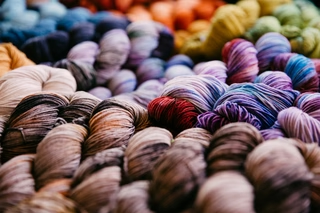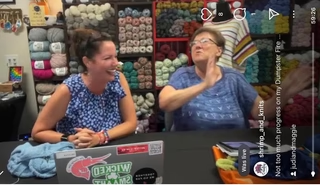This colorway is basically birdwatching without the binoculars. Inspired by everyone’s favorite winter show-off, Captivating Cardinal blends fiery scarlet, warm chestnut, soft blush, and a little charcoal shadow—like a cardinal perched on bare branches saying, “Yes, I know I’m stunning, thanks.”
Each skein carries that same mix of energy and elegance—bold enough to pop, grounded enough to keep things wearable. Perfect for shawls that sing, sweaters with rustic charm, or socks that deliver a little “cheer-cheer-cheer” with every step.
In short: it’s nature’s drama, bottled in yarn.
Materials: 100 % Extrafine Merino Superwash
Yardage: 166m (181yds) per 100g
Weight: Worsted (Aran) Weight
Needle Size: US 7-9 (4.5mm - 5.5mm)
Hook Size: US I-9 To K-10.5 (5.5mm - 6.5mm)
Stitches per 4in (10cm): Knit 16 - 20 Stitches / Single Crochet 11 - 14 Stitches
Machine Washable: No, handwash. See below for their instructions
The main factor determining the quality of merino wool is its softness which depends upon the fineness of the fibres. We use extra fine merino (19.5 microns) which is some of the finest commercially available for hand dyers. This results in a super soft yarn that feels gentle against the skin.
It is important for us to know where the fibres used in our yarns come from and to ensure they are produced and processed in ways that do not harm the animals or the environment. Our fibres are sourced from reliable material suppliers where we can establish best practice in relation to animal husbandry and the environment, as well as the best rearing and grading practices.
No animals are injured to provide our fibre as we only use shorn or material that has shed naturally from the animal.
The merino fibre we use is from sheep where mulesing is NOT practiced. We purchase the majority of our 19.5 micron merino from Australia and we pay a premium to purchase only Australian wool which is certified as mulesing free. The remainder of our merino is sourced from South America where mulesing is not necessary due to the climate. All of our wool is sourced from farms which comply with high animal welfare standards.
The majority of superwash yarn is treated using the Hercosett process, which is the method used for our superwash yarns too. Many people are rightly concerned over the potential impacts this process can have on the environment. The main concern being about how the waste water containing spent chemicals is dealt with after processing. We only use reputable companies to superwash our fibres, companies who hold ISO14001 accreditation and/or engage in best practice with regard to environmental performance and waste water treatment and re-use. Most of the effluent from the process is re-used and any disposed of has to meet strict environmental standards.
Here’s how to wash your hand-dyed wool items with care!
1. **Washing**: Always hand wash in **cold water** using a wool wash or a gentle detergent like Dawn dish soap. While wool washes are great, be cautious—they can sometimes cause colors to bleed. Even though our yarns are Superwash, handling them gently is key. The rule here is: better safe than sorry!
2. **Rinsing**: Once washed, gently squeeze out the excess water—**never wring or twist** the yarn, as this can damage the fibers. Instead, carefully press the water out.
3. **Absorbing Moisture**: Lay the item flat on a towel, then roll the towel up with the item inside to help absorb extra water. You can repeat this step with a second towel if needed.
4. **Drying**: Once most of the moisture is absorbed, carefully **lay your item flat to dry**. Make sure to spread it out on a clean, dry surface, reshaping it if necessary to maintain its original shape. Avoid hanging it up, as this can stretch the fibers. Let it dry naturally—air drying is best for wool.
5. **Color Fastness Tip**: Some suggest adding a few tablespoons of vinegar to the wash to help maintain color. While we heat set all our yarns and allow them to cool in the dye bath to prevent bleeding, scented detergents or very hot water can sometimes pull dye out. Stick to **mild detergents and cool water** to keep your colors vibrant.
Remember, avoiding hot water is essential—cold, cool, or room-temperature water is always safe!
This colorway is basically birdwatching without the binoculars. Inspired by everyone’s favorite winter show-off, Captivating Cardinal blends fiery scarlet, warm chestnut, soft blush, and a little charcoal shadow—like a cardinal perched on bare branches saying, “Yes, I know I’m stunning, thanks.”
Each skein carries that same mix of energy and elegance—bold enough to pop, grounded enough to keep things wearable. Perfect for shawls that sing, sweaters with rustic charm, or socks that deliver a little “cheer-cheer-cheer” with every step.
In short: it’s nature’s drama, bottled in yarn.
Materials: 100 % Extrafine Merino Superwash
Yardage: 166m (181yds) per 100g
Weight: Worsted (Aran) Weight
Needle Size: US 7-9 (4.5mm - 5.5mm)
Hook Size: US I-9 To K-10.5 (5.5mm - 6.5mm)
Stitches per 4in (10cm): Knit 16 - 20 Stitches / Single Crochet 11 - 14 Stitches
Machine Washable: No, handwash. See below for their instructions
The main factor determining the quality of merino wool is its softness which depends upon the fineness of the fibres. We use extra fine merino (19.5 microns) which is some of the finest commercially available for hand dyers. This results in a super soft yarn that feels gentle against the skin.
It is important for us to know where the fibres used in our yarns come from and to ensure they are produced and processed in ways that do not harm the animals or the environment. Our fibres are sourced from reliable material suppliers where we can establish best practice in relation to animal husbandry and the environment, as well as the best rearing and grading practices.
No animals are injured to provide our fibre as we only use shorn or material that has shed naturally from the animal.
The merino fibre we use is from sheep where mulesing is NOT practiced. We purchase the majority of our 19.5 micron merino from Australia and we pay a premium to purchase only Australian wool which is certified as mulesing free. The remainder of our merino is sourced from South America where mulesing is not necessary due to the climate. All of our wool is sourced from farms which comply with high animal welfare standards.
The majority of superwash yarn is treated using the Hercosett process, which is the method used for our superwash yarns too. Many people are rightly concerned over the potential impacts this process can have on the environment. The main concern being about how the waste water containing spent chemicals is dealt with after processing. We only use reputable companies to superwash our fibres, companies who hold ISO14001 accreditation and/or engage in best practice with regard to environmental performance and waste water treatment and re-use. Most of the effluent from the process is re-used and any disposed of has to meet strict environmental standards.
Here’s how to wash your hand-dyed wool items with care!
1. **Washing**: Always hand wash in **cold water** using a wool wash or a gentle detergent like Dawn dish soap. While wool washes are great, be cautious—they can sometimes cause colors to bleed. Even though our yarns are Superwash, handling them gently is key. The rule here is: better safe than sorry!
2. **Rinsing**: Once washed, gently squeeze out the excess water—**never wring or twist** the yarn, as this can damage the fibers. Instead, carefully press the water out.
3. **Absorbing Moisture**: Lay the item flat on a towel, then roll the towel up with the item inside to help absorb extra water. You can repeat this step with a second towel if needed.
4. **Drying**: Once most of the moisture is absorbed, carefully **lay your item flat to dry**. Make sure to spread it out on a clean, dry surface, reshaping it if necessary to maintain its original shape. Avoid hanging it up, as this can stretch the fibers. Let it dry naturally—air drying is best for wool.
5. **Color Fastness Tip**: Some suggest adding a few tablespoons of vinegar to the wash to help maintain color. While we heat set all our yarns and allow them to cool in the dye bath to prevent bleeding, scented detergents or very hot water can sometimes pull dye out. Stick to **mild detergents and cool water** to keep your colors vibrant.
Remember, avoiding hot water is essential—cold, cool, or room-temperature water is always safe!


To die for yarn
Textures, fibers, colors...an artist's playground.

Classes for all abilities
Whether new to the art, or fibre is in your DNA - we have something for everyone at Low Country Shrimp and Knits.



